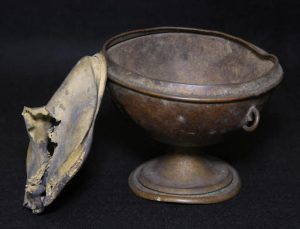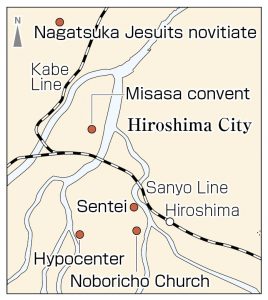Researcher confirms that 16 Jesuits experienced Hiroshima A-bombing and told world of tragedy
Nov. 12, 2019
by Masami Nishimoto, Staff Writer
A researcher’s investigation has revealed that 16 foreign priests and monks of the Society of Jesus experienced the atomic bombing on August 6, 1945. This investigation has confirmed that there were four German priests at the Noboricho Church (now part of Naka Ward), one priest in Kusunki-cho (now part of Nishi Ward), and 11 people at the Nagatsuka Jesuit novitiate located in Gion-cho (now part of Asaminami Ward), including a Spanish superior and two Korean missionaries. Amid the unprecedented catastrophe of the atomic bombing, they engaged in rescue efforts to aid the victims and promptly sought to convey the actual conditions in Hiroshima to the world. Pope Francis, who is set to visit Hiroshima on November 24, is originally from the Society of Jesus, too.
While the media had covered stories about some of the foreign clergy who experienced the atomic bombing — including Father Hugo Lassalle, a priest who contributed to the establishment of the Memorial Cathedral for World Peace, which was completed in 1954 as “a symbol of mourning and consoling the spirits of the A-bomb victims, and friendship and peace among people,” and Father Pedro Arrupe, who led the rescues of those who evacuated to Nagatsuka after the bombing and assumed the post of Superior General of the Society of Jesus in 1965 — the entire picture of the A-bombed priests remained unknown.
Chie Shijo, 41, a researcher from Hiroshima who is part of the Research Fellowship for Young Scientists program of the Japan Society for the Promotion of Science, explored the materials stored at the society’s Japan province in Tokyo and uncovered some documents that included a report submitted by the Nagatsuka Jesuit novitiate to the society’s headquarters in Rome. With the cooperation of Michael Milward, 74, an honorary professor from Sophia University who studied the conditions of the Jesuits in Hiroshima with a list of names of those who were in missionary places in Japan in 1945 — a list that was compiled and held by the society’s German province — I also traced and confirmed the A-bomb experiences of each of the priests and missionaries.
Four priests that included Father Lassalle, the missionary superior, experienced the atomic bombing at the wooden priests’ house on the grounds of the Noboricho Church, located about 1.2 kilometers east of the hypocenter. They then helped three family members of the missionaries who had been living on the church grounds and, along with two nurses, fled to Sentei (now known as Shukkeien Garden) located along the Kyobashi River. A Japanese divinity student headed to the novitiate in Nagatsuka to report on the conditions of the bombing.
Johannes Siemes, a priest who taught at Sophia University, which had been established by the society, and other priests also evacuated to the monastery. While being mistaken for Americans, Father Siemes and the others entered the city center and rescued Hiroshima citizens from the wreckage of collapsed buildings.
In those days, natives from Germany, an ally of Japan, and Spain, a neutral country, were able to evade detention in Japan, but some of the priests at the Nagatsuka Jesuit novitiate were moved to the Taishakukyo Valley in the northern part of Hiroshima Prefecture on August 1. Except for those whose whereabouts were unknown on August 6, 11 people have been identified as A-bomb victims.
In addition, it was found that Father Peter Kopp, along with some nuns, was exposed to the atomic bombing at the Misasa convent of soeurs Auxiliatrices Japon located in Kusunoki-cho, Nishi Ward. Father Kopp also went to the Nagatsuka novitiate with seven people including two Japanese, two French, two Italian, and one Irish, to help the victims.
Furthermore, it was found that the Manhattan district atomic bomb investigating group from the U.S. forces obtained a note written by Father Siemes one month after the atomic bombing. The group included the full text of his account in its report submitted in June 1946, and an excerpt appeared in Time magazine in its issue published on February 11, 1946. It was also confirmed that Father Lassalle’s written account was published in the society’s newsletter in March 1946.
Hiroshima functioned as a base for Society of Jesus activities
Comment from Chie Shijo, the researcher who carried out this investigation:
Nagasaki may be thought of as the home ground for the Catholic Church in Japan, but Hiroshima was the base for the Society of Jesus’s missionary activities. After experiencing the atomic bombing, the society’s priests and monks promptly conveyed the horrific conditions of the atomic bombing to the world by making use of their international network and language abilities. In this sense, they played a significant role. Catholics from the Korean Peninsula experienced the atomic bombing in Hiroshima, too. I hope the upcoming visit to Hiroshima by Pope Francis will provide an opportunity for people to take a look at the suffering the priests and monks experienced as a result of the atomic bombing, something that has not often been mentioned.
Keywords
The Society of Jesus
A monastery of the Catholic Church. Francisco Xavier, who brought Christianity to Japan in 1549, was one of the society’s founders. Missionaries from the society visited Japan again in 1908 and devoted themselves to the development of education in Japan, including the establishment of Sophia University. From the 1920s, the society began engaging in missionary activities in the Hiroshima area, covering five prefectures in the Chugoku region. The society continues to pursue its worldwide efforts today.
(Originally published on November 12, 2019)
A researcher’s investigation has revealed that 16 foreign priests and monks of the Society of Jesus experienced the atomic bombing on August 6, 1945. This investigation has confirmed that there were four German priests at the Noboricho Church (now part of Naka Ward), one priest in Kusunki-cho (now part of Nishi Ward), and 11 people at the Nagatsuka Jesuit novitiate located in Gion-cho (now part of Asaminami Ward), including a Spanish superior and two Korean missionaries. Amid the unprecedented catastrophe of the atomic bombing, they engaged in rescue efforts to aid the victims and promptly sought to convey the actual conditions in Hiroshima to the world. Pope Francis, who is set to visit Hiroshima on November 24, is originally from the Society of Jesus, too.
While the media had covered stories about some of the foreign clergy who experienced the atomic bombing — including Father Hugo Lassalle, a priest who contributed to the establishment of the Memorial Cathedral for World Peace, which was completed in 1954 as “a symbol of mourning and consoling the spirits of the A-bomb victims, and friendship and peace among people,” and Father Pedro Arrupe, who led the rescues of those who evacuated to Nagatsuka after the bombing and assumed the post of Superior General of the Society of Jesus in 1965 — the entire picture of the A-bombed priests remained unknown.
Chie Shijo, 41, a researcher from Hiroshima who is part of the Research Fellowship for Young Scientists program of the Japan Society for the Promotion of Science, explored the materials stored at the society’s Japan province in Tokyo and uncovered some documents that included a report submitted by the Nagatsuka Jesuit novitiate to the society’s headquarters in Rome. With the cooperation of Michael Milward, 74, an honorary professor from Sophia University who studied the conditions of the Jesuits in Hiroshima with a list of names of those who were in missionary places in Japan in 1945 — a list that was compiled and held by the society’s German province — I also traced and confirmed the A-bomb experiences of each of the priests and missionaries.
Four priests that included Father Lassalle, the missionary superior, experienced the atomic bombing at the wooden priests’ house on the grounds of the Noboricho Church, located about 1.2 kilometers east of the hypocenter. They then helped three family members of the missionaries who had been living on the church grounds and, along with two nurses, fled to Sentei (now known as Shukkeien Garden) located along the Kyobashi River. A Japanese divinity student headed to the novitiate in Nagatsuka to report on the conditions of the bombing.
Johannes Siemes, a priest who taught at Sophia University, which had been established by the society, and other priests also evacuated to the monastery. While being mistaken for Americans, Father Siemes and the others entered the city center and rescued Hiroshima citizens from the wreckage of collapsed buildings.
In those days, natives from Germany, an ally of Japan, and Spain, a neutral country, were able to evade detention in Japan, but some of the priests at the Nagatsuka Jesuit novitiate were moved to the Taishakukyo Valley in the northern part of Hiroshima Prefecture on August 1. Except for those whose whereabouts were unknown on August 6, 11 people have been identified as A-bomb victims.
In addition, it was found that Father Peter Kopp, along with some nuns, was exposed to the atomic bombing at the Misasa convent of soeurs Auxiliatrices Japon located in Kusunoki-cho, Nishi Ward. Father Kopp also went to the Nagatsuka novitiate with seven people including two Japanese, two French, two Italian, and one Irish, to help the victims.
Furthermore, it was found that the Manhattan district atomic bomb investigating group from the U.S. forces obtained a note written by Father Siemes one month after the atomic bombing. The group included the full text of his account in its report submitted in June 1946, and an excerpt appeared in Time magazine in its issue published on February 11, 1946. It was also confirmed that Father Lassalle’s written account was published in the society’s newsletter in March 1946.
Hiroshima functioned as a base for Society of Jesus activities
Comment from Chie Shijo, the researcher who carried out this investigation:
Nagasaki may be thought of as the home ground for the Catholic Church in Japan, but Hiroshima was the base for the Society of Jesus’s missionary activities. After experiencing the atomic bombing, the society’s priests and monks promptly conveyed the horrific conditions of the atomic bombing to the world by making use of their international network and language abilities. In this sense, they played a significant role. Catholics from the Korean Peninsula experienced the atomic bombing in Hiroshima, too. I hope the upcoming visit to Hiroshima by Pope Francis will provide an opportunity for people to take a look at the suffering the priests and monks experienced as a result of the atomic bombing, something that has not often been mentioned.
Keywords
The Society of Jesus
A monastery of the Catholic Church. Francisco Xavier, who brought Christianity to Japan in 1549, was one of the society’s founders. Missionaries from the society visited Japan again in 1908 and devoted themselves to the development of education in Japan, including the establishment of Sophia University. From the 1920s, the society began engaging in missionary activities in the Hiroshima area, covering five prefectures in the Chugoku region. The society continues to pursue its worldwide efforts today.
(Originally published on November 12, 2019)









